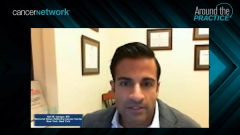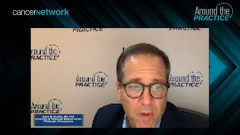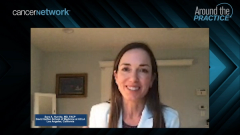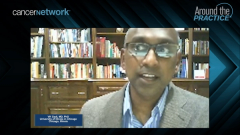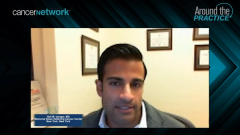
Frontline Standards of Care for HER2+ MBC
Episodes in this series

Adam M. Brufsky, MD, PhD: Welcome to this Cancer Network® presentation “Around the Practice: Relapsed/Refractory HER2+ Metastatic Breast Cancer.”
I am your host, Dr Adam Brufsky, from the University of Pittsburgh Medical Center in Pittsburgh, Pennsylvania. Joining me today are Dr Neil Iyengar from Memorial Sloan Kettering Cancer Center in New York, New York; Dr Sara Hurvitz from the David Geffen School of Medicine at UCLA [University of California, Los Angeles] in Los Angeles, California; and Dr VK Gadi from the University of Illinois in Chicago, Illinois.
Today we are going to talk about emerging standards of care in HER2 [human epidermal growth factor receptor 2]–positive metastatic breast cancer, review 2 patient cases, and involve our audience by using an interactive online platform to answer several polling questions that will then be discussed by our panelists. In addition, because we’re doing this live, we’re going to do ask the audience to ask us questions in real time. We will go through the case, go through the polling, talk for a bit, and then ask the audience if they have any questions at the end of each subsegment. It will be very interactive as we do this. Let’s start.
We have a polling question. What percentage of your patients have breast cancer: 0% to 25%, 26% to 50%, 51% to 75%, or 76% to 100%? If you can, please vote.
This is a very breast cancer–oriented audience. Almost everybody has a practice almost completely defined as breast cancer. The poll has ended. About half the responses have 75% or more, and the other half has 50% or less. It’s an interesting mix of patients.
The treatment of HER2+ metastatic breast cancer is 1 of the success stories in oncology. I guess you guys are a little younger than I am, but I was there when Sara’s mentor gave the presentation in 1998 in Orlando when we all saw this. I still remember that day. It really has changed things. It introduces a lot of issues that we’re trying to encounter, like what’s really positive, who responds, and what to give in each regimen if you ever become resistant to trastuzumab. Sara, what’s your impression of the standard of care in HER2+ breast cancer right now in the first line? If someone walks through the door with first-line disease, what would you do?
Sara A. Hurvitz, MD, FACP: It’s a great question—and yes, I know you were in the audience there, Adam. I just want to note I was just graduating high school.
Adam M. Brufsky, MD, PhD: That’s how old I am.
Sara A. Hurvitz, MD, FACP: I’m going backward in time. I’m totally kidding.
Dr Suzette Delaloge and colleagues at ESMO [European Society for Medical Oncology Congress] last fall presented some interesting real-world data from French cancer centers looking at the overall survival of breast cancers from the time of metastatic diagnosis and the disease course, based on disease biology; hormone receptor positive, triple negative, or HER2+ for patients diagnosed from 2008 to 2017. It’s fascinating to see that in HER2+ breast cancer, the median overall survival in that time period increased substantially. It’s now getting close to 5 years median overall survival—not even reached in the more recent years.
In contrast, those with triple-negative breast cancer stuck right around a year median overall survival. Interestingly, hormone receptor–positive and HER2-negative breast cancer hasn’t improved over that time period. Maybe it will now with the uptick in CDK4/6 inhibitor use. It’s important to have that sense of optimism because HER2-targeted therapies have improved outcomes for our patients, but we also aren’t curing HER2+ metastatic disease. In the frontline setting, the standard as of January 2021 is taxane with trastuzumab and pertuzumab, based on the CLEOPATRA trial. In the next year or 2, maybe we will have a new standard as some of the newer therapies we’ll be talking about today move up and challenge that first-line approach.
Adam M. Brufsky, MD, PhD: I have a question for Neil because he comes from Memorial [Sloan Kettering Cancer Center], where this work was done. A lot of people substitute paclitaxel for docetaxel. Do we have a lot of data for that? I know of only about 1 fairly small trial. Do we have any other data other than the trial that you guys did a couple years ago?
Neil M. Iyengar, MD: That’s a great question. That trial, which we published a couple of years ago, was led by Dr Chau Dang with Dr Clifford Hudis. It was a phase 2 single-arm trial that was geared to looking at toxicity. A lot of what we’ve done with replacing Taxol or replacing docetaxel with Taxol is simply to present alternative scheduling and treatment options. We know that the AEs [adverse events] associated with that regimen are manageable. In our anecdotal experience, we start a little easier to manage them with docetaxel. That’s important because, as we start to talk about metastatic disease where median PFS [progression-free survival] continues to be prolonged, a treatment approach that is more manageable in the long term is important.
One thing that is really important to point out—it is a single-arm phase 2 trial with Taxol, Herceptin, and pertuzumab in the metastatic setting—about that trial is that we have subsequently published follow-up data where the approach is to turn on and off the Taxol. That’s a fairly standard approach.
We do find that with that regimen, stopping Taxol with disease stability or disease response, and even entering a period of maintenance therapy—antibodies alone, antibodies with hormonal therapy, and so forth—presents a very exciting research opportunity for how we might prolong that period of antibody-based therapy with a partner that may not necessarily have to be Taxol or chemotherapy in general. Perhaps resorting to adding back the chemotherapy at disease progression or when we need to synergize the effect of the antibody. For me, that was the largest takeaway from that study and approach. It was not just an alternative treatment approach for AE management but also specifically introducing the concept of a maintenance period.
Adam M. Brufsky, MD, PhD: Let’s stay on taxane for a minute. VK, we definitely have the Athenex drug, Oraxol, and then we have tesetaxel. Can you imagine the day when we’re going to start using oral taxanes in the first line? And it will go even further: oral taxanes with subcutaneous trastuzumab-pertuzumab. Do you want to talk about that?
VK Gadi, MD, PhD: Yes, that’s clearly where we’re heading. That’s a real boon for patients: not having to come in once a week or for long infusion times or chair times, and being able to get oral agents in these contexts. There is some evidence, though it might be preclinical, that overcoming taxane resistance is possible with these oral agents. The tesetaxel in particular is not a substrate for P-glycoproteins, so it’s not being effluxed out of cells that might have already experienced the taxane. Similarly, when you combine the Oraxol with the inhibitor of the P-glycoprotein, the same phenomena is happening.
What makes them oral therapies and effective as oral therapies is also likely to potentially overcome innate resistance that these cancers may have experienced in the metastatic setting. You might get more life out of these oral taxanes. I know that’s theory and conjecture, but I can see that day happening. We’ve seen these studies looking at patient preference related to the subcutaneous formulations of trastuzumab and pertuzumab. It’s clearly a winner from the patient’s perspective as well. We’re probably going to push the needle on this.
I want to address 1 other thing, which is an interesting phenomenon. We’re changing the natural history of what we’re seeing in the metastatic setting to some degree. A lot of patients are successfully treated with these same agents forever in the early stage setting. We’re also starting to see more inexperienced cancers in the metastatic setting; tumors that are de novo metastatic disease. The opportunity there for a cure is very real. A lot of those patients can get very good, stable long-term disease control. At some point, we might call that a cure. There’s a lot of shifting and moving going on in the HER2 space. What we define and how we define our first-line options are going to be very different based on how experienced those cancers were from in the adjuvant setting or not.
Adam M. Brufsky, MD, PhD: I totally agree. I was really fascinated. You guys probably saw this paper—it was in The Oncologist a couple of years ago. It was from [The University of Texas] MD Anderson [Cancer Center]. They went back in their database and, if you had a clinical CR [complete response] metastatic disease at any time—it could be 2 years later—you had about a 96% 10-year survival. It was amazing.
VK Gadi, MD, PhD: It was achievable for 10% to 15% of patients at that time.
Adam M. Brufsky, MD, PhD: Right. That’s just incredible. I get the sense it’s almost like lymphoma. We don’t do as many lymphomas as we used to, if any, but remember 30% of the patients had basically a long-term cure. They wouldn’t relapse for 5, 7, or 8 years. It seems that this disease is like that. Sara, what do you think? You have those patients who are exceptional responders. I’m just getting that sense in this disease. I don’t know what you guys think.
Sara A. Hurvitz, MD, FACP: The trick is knowing who they are when you’re starting therapy and how to determine who we dare to stop therapy in. Right now, we don’t know. If you recall, 1 of Dr Dennis Slamon’s first patients in the Lifetime movie Living Proof—about the phase 1 trial of trastuzumab—was cured. She had lung metastases and I believe bone metastases. She received only a certain amount of therapy in the trial—that’s all they funded—and she had a complete response and has not recurred to date. He still stays in touch with her.
For 1 of my earliest patients, in 2007, we initiated taxane-trastuzumab–based therapy, and she had a complete response in liver metastases and was maintained on trastuzumab over 10 years. We started dancing around the idea of stopping therapy. She chose not to and has recently progressed. I don’t feel that I have the tools to decide who can safely come off. There are some patients for whom, in a shared way, we’ve decided to stop therapy, watch closely, and see what happens. We don’t know if we’re harming patients by doing that for this subtype of breast cancer. Given the lack of evidence, it needs to be a shared decision at this point. I do agree that probably somewhere around 10% or 15% of patients are able to achieve a long-term durable remission.
Adam M. Brufsky, MD, PhD: Yes, it’s incredible. I have a woman whom I treated in 1999 with TH [paclitaxel, trastuzumab], and she had liver metastases 3 months after adjuvant docetaxel without trastuzumab. We gave her trastuzumab and paclitaxel for about half a year, everything went away. She still has her port, 21 years clear. It hasn’t been taken out. She wouldn’t let us take it out.
Sara A. Hurvitz, MD, FACP: Is she still taking trastuzumab?
Adam M. Brufsky, MD, PhD: Yes. She refuses to come off it. She had a lung cancer. It’s crazy. That’s where we are. It’s a cool time to be around this field. This is truly 1 of the success stories. The CDK4/6 inhibitors have changed the way we treat people.
Transcript edited for clarity.
Newsletter
Stay up to date on recent advances in the multidisciplinary approach to cancer.


